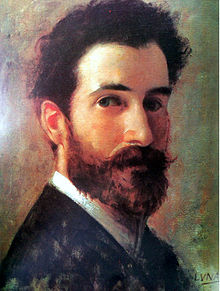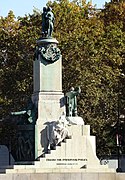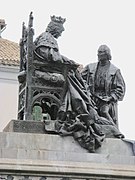Mariano Benlliure
Mariano Benlliure y Gil | |
|---|---|
 Portrait of Mariano Benlliure in his youth by his friend, Filipino painter Juan Luna[1] | |
| Born | Mariano Benlliure y Gil (1862-09-08)September 8, 1862 Valencia, Spain |
| Died | November 9, 1947(1947-11-09) (aged 85) Madrid, Spain |
| Known for | Sculpting, Painting |
| Movement | Heroic realism, Neoclassicism |
Mariano Benlliure (8 September 1862 – 8 November 1947) was a Spanish sculptor, who executed many public monuments and religious sculptures in Spain, working in a heroic realist style.[2]
He was born in El Grau quarter of Valencia. His earliest sculptures featured bullfighting themes,[3] modeled in wax and cast in bronze. At the age of thirteen he showed a wax modello of a picador at the Exposición Nacional de Bellas Artes, 1876. Pursuing the thought of becoming a painter, he went to Paris his expenses paid by his master, Francisco Domingo Marqués. A trip to Rome in 1879, revealing at first hand the sculptures of Michelangelo convinced him to be a sculptor. In 1887 he established himself permanently in Madrid, where in that year's Exposición Nacional his portrait sculpture of the painter Ribera won him a first-prize.[2]
Benlliure's style is characterized by detailed naturalism allied to an impressionistic spontaneity. His portrait busts and public monuments are numerous, and include:
- the tomb of Práxedes Mateo Sagasta in the Pantheon of Illustrious Men, Madrid
- monument to José de San Martín, Lima, Peru
- a bronze memorial to María Cristina de Borbón, Madrid
- the bronze equestrian statue of Alfonso XII of Spain, in Madrid's Buen Retiro Park, the centerpiece of a memorial designed by architect José Grases Riera
He was depicted on the Spanish 500 ptas banknote in the 1950s, with his sculpture "Sepulchro De Gayarre en el Roncal" on the reverse.
His brothers José and Juan Antonio were also painters.
Works
.mw-parser-output .mod-gallery{display:table}.mw-parser-output .mod-gallery-default{background:transparent;margin-top:0.5em}.mw-parser-output .mod-gallery-center{margin-left:auto;margin-right:auto}.mw-parser-output .mod-gallery-left{float:left}.mw-parser-output .mod-gallery-right{float:right}.mw-parser-output .mod-gallery-none{float:none}.mw-parser-output .mod-gallery-collapsible{width:100%}.mw-parser-output .mod-gallery .title{display:table-row}.mw-parser-output .mod-gallery .title>div{display:table-cell;text-align:center;font-weight:bold}.mw-parser-output .mod-gallery .main{display:table-row}.mw-parser-output .mod-gallery .main>div{display:table-cell}.mw-parser-output .mod-gallery .caption{display:table-row;vertical-align:top}.mw-parser-output .mod-gallery .caption>div{display:table-cell;display:block;font-size:94%;padding:0}.mw-parser-output .mod-gallery .footer{display:table-row}.mw-parser-output .mod-gallery .footer>div{display:table-cell;text-align:right;font-size:80%;line-height:1em}.mw-parser-output .mod-gallery .gallerybox .thumb img{background:none}.mw-parser-output .mod-gallery .bordered-images img{border:solid #eee 1px}.mw-parser-output .mod-gallery .whitebg img{background:#fff!important}.mw-parser-output .mod-gallery .gallerybox div{background:#fff!important}

Monument to Álvaro de Bazán, 1891 (Madrid)

Equestrian statue of Alfonso XII of Spain, 1928 (Madrid)

Monument to Emilio Castelar, 1908 (Madrid)

Monument to Queen Elizabeth and Columbus (Granada)
References
^ Santiago Albano Pilar (1980). Juan Luna, the Filipino as painter. Eugenio Lōpez Foundation. p. 56..mw-parser-output cite.citation{font-style:inherit}.mw-parser-output .citation q{quotes:"""""""'""'"}.mw-parser-output .citation .cs1-lock-free a{background:url("//upload.wikimedia.org/wikipedia/commons/thumb/6/65/Lock-green.svg/9px-Lock-green.svg.png")no-repeat;background-position:right .1em center}.mw-parser-output .citation .cs1-lock-limited a,.mw-parser-output .citation .cs1-lock-registration a{background:url("//upload.wikimedia.org/wikipedia/commons/thumb/d/d6/Lock-gray-alt-2.svg/9px-Lock-gray-alt-2.svg.png")no-repeat;background-position:right .1em center}.mw-parser-output .citation .cs1-lock-subscription a{background:url("//upload.wikimedia.org/wikipedia/commons/thumb/a/aa/Lock-red-alt-2.svg/9px-Lock-red-alt-2.svg.png")no-repeat;background-position:right .1em center}.mw-parser-output .cs1-subscription,.mw-parser-output .cs1-registration{color:#555}.mw-parser-output .cs1-subscription span,.mw-parser-output .cs1-registration span{border-bottom:1px dotted;cursor:help}.mw-parser-output .cs1-ws-icon a{background:url("//upload.wikimedia.org/wikipedia/commons/thumb/4/4c/Wikisource-logo.svg/12px-Wikisource-logo.svg.png")no-repeat;background-position:right .1em center}.mw-parser-output code.cs1-code{color:inherit;background:inherit;border:inherit;padding:inherit}.mw-parser-output .cs1-hidden-error{display:none;font-size:100%}.mw-parser-output .cs1-visible-error{font-size:100%}.mw-parser-output .cs1-maint{display:none;color:#33aa33;margin-left:0.3em}.mw-parser-output .cs1-subscription,.mw-parser-output .cs1-registration,.mw-parser-output .cs1-format{font-size:95%}.mw-parser-output .cs1-kern-left,.mw-parser-output .cs1-kern-wl-left{padding-left:0.2em}.mw-parser-output .cs1-kern-right,.mw-parser-output .cs1-kern-wl-right{padding-right:0.2em}
^ ab España es Cultura. "Mariano Benlliure". Ministry of Education, Culture and Sport, Government of Spain. Retrieved December 4, 2014.
^ "Neoclassicism: Mariano Benlliure". Spanish Arts. 2011. Retrieved December 4, 2014.
| Wikimedia Commons has media related to Mariano Benlliure. |
This article about a Spanish sculptor is a stub. You can help Wikipedia by expanding it. |





Comments
Post a Comment